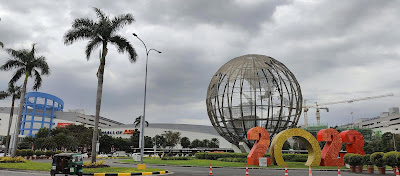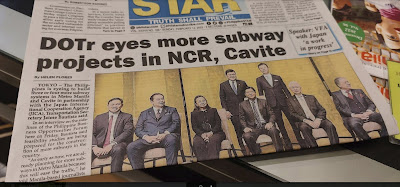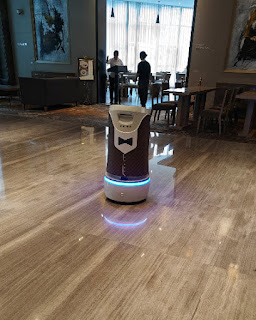Experiences on e-commerce and retail in the Philippines
I am currently traveling around the Philippines, great country, very nice people. As always I pay attention to retail and digital commerce as it is my hobby. I will describe a few experiences/pictures from what took my attention during my travel.
If you are in a hurry, then just watch the video, I made on retail and commerce in the Philippines, if you are not in a hurry, read the complete post for more details:
You can watch the same video at "rumble", if you prefer that platform.
Brandnames
Philippines love to play around with brand names, like the pictures you see below. You can spend an entire day enjoying funny brand names if you like.
Super apps in Asia are awesome
The super apps that are used in most of SE Asia and China, also work very smoothly here. I used Grab, Joyride, AirAsia and probably I will need to use LalaMove also soon.These apps I really miss in Europe.
It is so incredibly convenient to use these super apps. You can get things done so fast and so easy.
As Grab says in an interview I read, they are problem solvers: "The model has proven successful, in part because Grab’s engineers are focused on problems that people face in real-life settings, or genba in Japanese. The company has helped millions of users open their first bank account, offered micro-loans to hundreds of thousands of its driver-partners, and helped grow their earnings on the Grab platform over time."
- Priority delivery of food, pay a little extra, get priority delivery, if it does not arrive at the time that is given, you will be given vouchers.
- An advertising block, where (in my case) often Lazada advertised.
- The 20% (or sometimes more discount) on self pickup, combined with special "self pickup lines" in stores for example coffee shops or fashion shops.
- The Pabili function, you can let someone pickup and deliver something. Can be anything up to medicine, groceries or just things you need to send to a company or person.
- Constant influx of new functionalities. The apps are blasting with new functionalities. Often you can signup for them (so they can test demand I guess), but the thing is, there is always a reason to use the app.
- FACE, checking in by facial recognition for Air Asia flights. Saves a lot of hassle.
- It is always possible to get direct help via chat, I tried it a few times, always solved my problem.
- Countless smart cross and up sell possibilities that are either not used in the west or not possible because the service is not available.
- The loyalty programmes are setup in a smart and easy way. Rewards all over the apps.
- The "challenges" function is like a prize draw, but then more interactive, it gives tasks (like ordering food), gives a clear overview of the things you need to do, and in the end you can win (for example) a Dyson cleaner. They clearly indicate the amount of Dyson's that can be won. It's like a project in your app to complete.
- Despite the many topics, it's easy to either search or navigate to the main
categories. Just to give an example of the main categories in Grab, there is:
Food, Mart, Car, Mov It, Express, Pabili, Load, Bills, Shopping, Gifts, Offers, Experiences, Hotels, Challenges and Insurances. They are all easily accessible on the tiny screen. - I needed to have something delivered to another location. Its so easy to
just arrange a point to point delivery, someone just picks up the stuff
and brings it over to the desired location.
Retail experience: Shopping malls
Shopping malls always have a convenient temperature, and that alone is a reason for many Philippino's to spend a few hours in a shopping mall, to beat the heat outside.
The Mall of Asia
The mall of Asia is so huge I couldn't get it fit in one picture. It boosts 589,891 m2. It has several cinema's, a waterfront (amusement) park, an indoor skating rink (Olympic size), local brands, foreign brands, and really, really lot's of food options, the most I ever saw in a shopping mall.
SM shopping malls in the Philippines also broadcast regularly live events from their locations via their app and their website. It is then possible to do both an on, offline or combined purchase. If you order online and you live in an area near a shopping mall there is same day delivery. Haven't seen that in Europe.
Inside the mall, they also have their own SM branded stores.
A few suggestions for improvements:
- Make a guided route (online at least but preferably a combination) to pass all local brand shops. It is -as a tourist- nice to visit local brands, not only to buy them but sometimes also to source them.
- Because of its size it also helps to have high speed escalators, that skip a few floors. Makes it possible to get to your destination faster (f.e. the ice skate rink) I saw this in a shopping mall in Shanghai and a super escalator is really convenient.
- Integrate on and offline (also for tourists). Create a PWA (progressive web app) that you can use when you visit the mall. It helps you to find your way around. And do include suggestion one, the local brand route, but maybe also an offer route, experience route, or simply let it generate vouchers to use at this specific mall, after registration. Both vendor and visitor profit.
- Manila's traffic is so bad, that as a tourist it can be quite a hassle to get there if you do not want to take a taxi. Why not have several times a day a direct bus from the main tourist centers to the mall, Makati and Bonifacio high street.
I was alone, so I just took a motorbike taxi via joyride on my way in the first time. The second time, I took public transport. First a motorbike taxi to the MRT, then wait in line there to buy tickets, then go to TAFT terminal station and from there there is no signage or posting, where to go, in the end I figured out which jeepney to take and then you are indeed in 10 minutes at the mall. But I would not recommend this route if you are there with children. Taft station is very chaotic and jeepneys very crowded.
So many opportunities to help shopping malls like this or retail experiences, like this with user stories /use cases, to improve the experience for tourists (and locals a like). But often, for tourists, the customer journeys can really be improved. I see so many things during traveling that are unclear for tourists, both digitally and physically.
So how to compare the retail experience in the Philippines with other regional destinations?
- Compared to China the payment processes are much easier to process. Here it happened to me a few times that some payment methods were not accepted, despite indicated on the front door, it happened to me with Bitcoin and Grab pay.
- Compared to China the transportation to the retail destinations takes more effort. In China everywhere there is very good and cheap public transport, often directly into a mall. Here you really have to take some effort. Same goes in comparison with Singapore, Tokyo and to a certain level Bangkok.
But I am sure the Philippines are working hard on improving that. - Lower end shopping malls are quite similar to those found in for example Shenzhen or MBK (Bangkok), or Ho Chi Minh City. Lot's of little stalls and vendors with all kinds of (fake) products. Always fun to shop in these venues, only here often cash is the main form of payment, while in China you can always use Wechat or Alipay, always, everywhere even in Tier 5 cities.
Sari-Sari shops
They sell basic goods, usually in small sachets and sometimes have a tiny restaurant as well.
It's very nice to read that there is help for the countless sari-sari shops to make a step into modernization. Some of the will grow to large business, I am sure of that. Even now, you see huge differences between the tiny shops, even in the same street or block.
Usually the name of the shop owner is directly on the sari sari sign so you have directly a conversation starter.
This sari sari shop had 3 chairs in front of the shop. On one, a guy is playing a traditional Philippine guitar, I think it is called Buktot, while the other chair is occupied by a guy working at his laptop and now the third one is occupied by me. That felt good, a direct connection between customers, shop owner and environment. It's that kind of feeling that makes it unique.
Payment preferences
Salary in the Philippines is paid two times a month. The salary
level is still low, this also (partly) explains why you can buy on
credit everywhere and also why many people here, prefer to buy "small
amounts".
Different from China, where it is either cash (a little) or WeChat pay or Alipay (or now the e-yuan) the payment ecosystem in the Philippines is quite broad. Many shops have a lot of different payment methods that they accept (or sometimes not when you ask).
Compared to China, that is known for the massive savings that households have, I got the feeling that is much less in the Philippines, much more is bought on credit and saving is not on top of people's list.
Cash is still very important, but also as written above, to buy on credit with for example G-Cash, I have seen that also at many places even in restaurants.
GrabPay or PayMaya online payment methods are increasingly popular. Although my experience so far is that outside the big cities GrabPay isn't really accepted a lot and even inside the big cities, sometimes they refused my GrabPay payment request.
I also noted that people (as happens more often in Asia, I used this service myself also regularly in China) use convenience stores to pay their utilities or other payments.
There are everywhere also countless top up options as many people use prepaid services.
With around 2 million Filipino's working abroad and sending money back home every month for extraordinary fee's there is now great news, as Strike has started in the Philippines. Now it is possible to send dollars and let them convert to pesos for almost no fee's via the bitcoin rail.
Most popular web shops in the Philippine
It is unclear (couldn't find data) if these are only direct online transctions or also transactions that are a combination between on and offline.
In the Philippines the platform Shopee is a very large platform and one of the most visited webshops in terms of traffic.
FB Messenger
I tried to contact the taxi driver who very decently brought me to and from the airport, wanted to give him a return ride. But only accessible via FB messenger, not even whatsapp.
The little company for the video tape conversions, only FB messenger.
Even SM shopping malls, have-I think really nice- a digital shopping buddy, but only available on messenger.
Outdoor advertising
Only place I saw a very limited amount of digital billboards was in Makati, especially near the airport.
Sim card registration in the Philippines
If
you want to use the internet in the Philippines to do some remote work,
many coffee shops or public WiFi are using a captive portal. A page you
have to login to with your phone number.
Of course this is highly
annoying. Captive portals are already annoying, giving often problems
with VPN services or connection issues, but the need to register which
also is only possible for a month at one time for a tourist, is even
more annoying.
The background
is (and from that perspective understandable) that many Filipino's that
work overseas are often scammed. Remittance money is a big thing here.
So it's important that this money arrives safely in the Philippines.
Now
the interfaces for the registration of your sim card is a bit of a
hassle, especially if you use your phone. You need to provide
screenshots and pictures. It involves a lot of switching windows.
It is not possible to register a sim card without giving many details. You need to provide:
- Proof of flying out (plane ticket f.e.)
- Make a selfie
- Proof of address (can just be your fist hotel, but that isn't clearly explained.
- Make a picture of your passport (complete with all details).
Now this is not working smoothly. It takes some frustration. For example this below, this is the mobile interface of the globe (my sim card) registration page. It requests you to upload a selfie. Pressing button activates the camera and lets you make a selfie. However it is impossible to upload, as only 4mb is accepted. Modern phones create much higher quality pictures.
Now I managed to bypass it by the use of the desktop version, but not everyone would think of such bypass.
Also you need to make so many screenshots, and you need to switch between windows.
So why not make sim card registration much easier for foreigners?
One needs to register already on this page, if you come over here, and you need to provide there also your passport and flight details.
Just
make a simple checkbox on this page at the end of the process with "do
you plan to buy a local sim card?" if a user clicks on it, it provides a
code.
When the user is in the Philippines , buys a sim card and
registers it online, all that is needed is to provide the new phone
number, the code and a passport picture. The latter is I think
unfortunately still needed to prove the person is the one who also
received the code.
Maybe in the future with e-sims and facial recognition this will be all easier.
They are on the right track
Bonifacio High street for example, made me feel of Xintiandi in Shanghai, large skyscrapers combined with lot's of shopping and entertainment, and a light warm breezy wind in your hair in the middle of a concrete jungle.
Compared to Vietnam, Thailand, it might lack (a little) behind, but they are on the right track. It will be transformed hugely in the next few years.
Transport is a big issue here, to get to shopping malls is often not easy or fun, and mostly always requires a taxi or other mean of transport in too crowded traffic.
Public transport is available but too crowded, or it has other obstacles.
I do however see ads everywhere for 100mbit lines, so I think they are rapidly improving that, even in small villages. But for now, my experience is, that it is not stable and not fast at most places. I had some difficulty video calling due to that.
I didn't see any (special) flagship or concept stores, like you would find in Shanghai, London or New York.
If I go to a sari sari shop, I can just relax there, sit and talk, enjoy the conversations. Get a connection.





.jpg)















Comments
Post a Comment